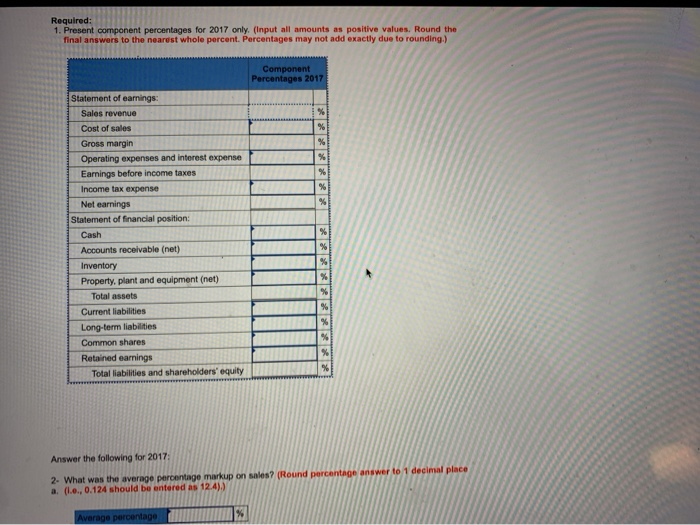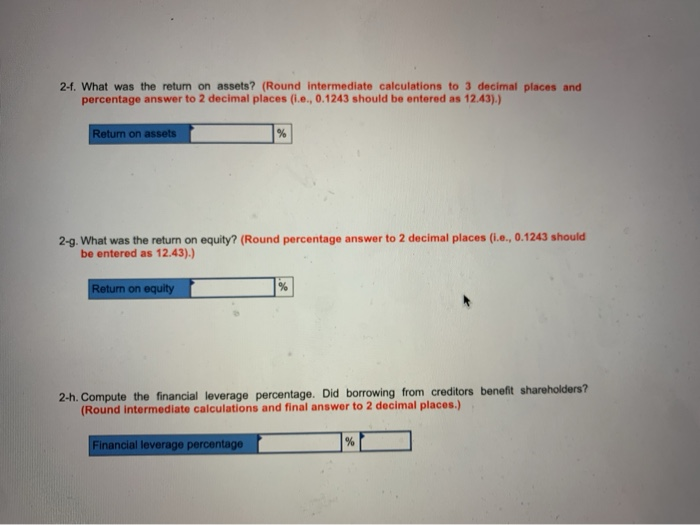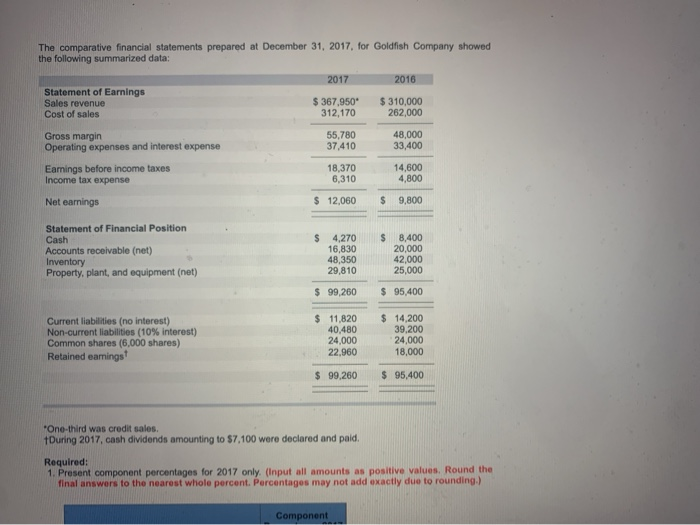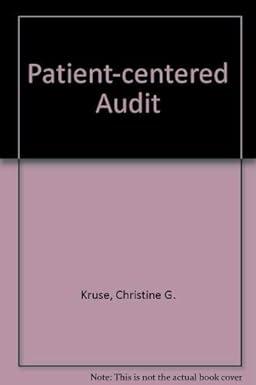


The comparative financial statements prepared at December 31, 2017, for Goldfish Company showed the following summarized data: 2017 2016 Statement of Earnings Sales revenue Cost of sales $367,950 312,170 $ 310,000 262,000 55,780 37,410 48,000 33,400 18,370 6,310 14,600 4,800 Gross margin Operating expenses and interest expense Eamings before income taxes Income tax expense Net earnings Statement of Financial Position Cash Accounts receivable (net) Inventory Property, plant, and equipment (net) $ 12,060 $ 9,800 $ 4.270 16,830 48,350 29,810 $ 8,400 20,000 42,000 25,000 $ 99,260 $ 95,400 Current liabilities (no interest) Non-current liabilities (10% interest) Common shares (6,000 shares) Retained earningst $ 11,820 40,480 24,000 22,960 $ 14,200 39,200 24,000 18,000 $ 99,260 $ 95,400 *One-third was credit sales. During 2017, cash dividends amounting to $7,100 were declared and paid. Required: 1. Present component percentages for 2017 only. (Input all amounts as positive values. Round the final answers to the nearest whole percent. Percentages may not add exactly due to rounding.) Component Required: 1. Present component percentages for 2017 only. (Input all amounts as positive values. Round the final answers to the nearest whole percent. Percentages may not add exactly due to rounding) Component Percentages 2017 % RE % % % Statement of earnings: Sales revenue Cost of sales Gross margin Operating expenses and interest expense Earnings before income taxes Income tax expense Net earnings Statement of financial position: Cash Accounts receivable (net) Inventory Property, plant and equipment (net) Total assets Current liabilities Long-term liabilities Common shares Retained earnings Total liabilities and shareholders' equity *** Answer the following for 2017: 2. What was the average percentage markup on sales? (Round percentage answer to 1 decimal place a. (L., 0.124 should be entered as 124).) Average percentage 2- What was the average income tax rate? (Round percentage answer to 1 decimal place (le, 0.124 b. should be entered as 12.4).) Average income tax % 2-c. Compute the net profit margin ratio. Was it a good or poor Indicator of performance? (Round percentage answer to 2 decimal places (.e., 0.1243 should be entered as 12.43).) Net profit margin ratio 2-d. What percentage of total resources was invested in property, plant, and equipment? (Round percentage answer to 2 decimal places (.e., 0.1243 should be entered as 12.437.) % Percentage 2-e. Compute the debt-to-equity ratio. Does it look good or bad? (Round the final answer to 2 decimal places.) Debt-to-equity rato 2-. What was the return on assets? (Round intermediate calculations to 3 decimal places and percentage answer to 2 decimal places (i.e., 0.1243 should be entered as 12.43).) Return on assets % 2-g. What was the return on equity? (Round percentage answer to 2 decimal places (.e., 0.1243 should be entered as 12.43).) Return on equity 1 2 h. Compute the financial leverage percentage. Did borrowing from creditors benefit shareholders? (Round intermediate calculations and final answer to 2 decimal places.) Financial leverage percentago %










